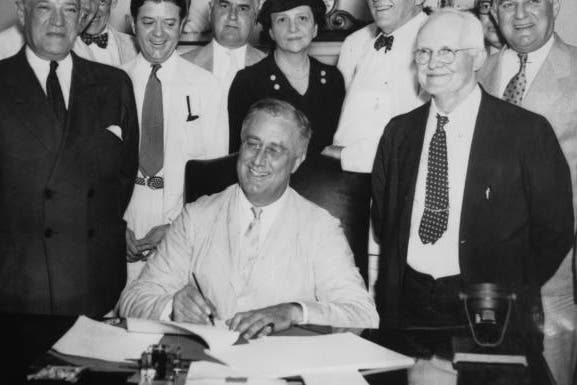
Social Security differed from other New Deal programs in that it wasn’t a short-term solution to the Great Depression. It was a long-term investment.
Published: April 11, 2023

During the Great Depression, President Franklin Delano Roosevelt passed a series of economic recovery measures known collectively as the New Deal. One of the most significant and lasting parts of the New Deal—the Social Security Act—established a contributory pension system for retired workers.
Since its passage, the United States has expanded Social Security multiple times. Despite attempts to dismantle or privatize the program, it has endured for nearly a century, in part, because FDR and his secretary of labor, Frances Perkins, designed it as something workers felt invested in.
Here's How the Great Depression Brought on Social SecurityBy the time FDR passed the Social Security Act in 1935, 34 nations already offered some form of social insurance, according to the Social Security Administration historian’s office. Many U.S. states also had workers’ compensation laws and old-age assistance programs for people who met certain qualifications.
During the Depression, with so many Americans suffering, lawmakers, economists and others debated whether the nation should create a federal old-age pension or an assistance program. But they disagreed about what it should look like. One of the most generous proposals came from California physician Francis Townsend, whose 1933 Townsend Plan called for the U.S. government to provide every person 60 years and older with $200 a month.
In 1934, FDR created the Committee on Economic Security to consider what unemployment or old-age programs the United States could adopt. Under the leadership of Secretary of Labor Perkins, the committee developed the idea for a contributory old-age pension plan. With this “Social Security” program, certain workers and their employers would make tax contributions to a trust fund that would later provide these workers with monthly payments starting at age 65.
Social Security stood out from other New Deal initiatives in that it wasn’t designed as a short-term program. The Works Progress Administration created projects that employed people who needed work immediately. But because workers had to make contributions to receive Social Security, people who enrolled in the program in 1935 were told they wouldn’t be able to receive benefits until 1942.
“That was seven years into the future at a time where a lot of people, including older people, were living in extreme poverty,” says Daniel Béland, a political science professor at McGill University and author of Social Security: History and Politics from the New Deal to the Privatization Debate.
One of the reasons FDR chose a contributory pension model was that he wanted a system that would pay for itself. “But there was another logic to this that Francis Perkins wrote about,” Béland says.
The idea was that because workers would help contribute to their Social Security pensions, they “will feel entitled to benefits,” he says. “And that will make it harder for other politicians—especially Republicans—to later on dismantle Social Security.”
While this proved true in the long run, it provided no help to people who needed immediate assistance in 1935. The fact that no one would actually see a benefit from the program for several years made Social Security particularly vulnerable to attacks during the 1936 presidential election.
Franklin D. Roosevelt Creates Social SecurityThe Social Security Act that FDR signed in 1935 provided recipients with much less than the Social Security program the United States has today. It didn’t include disability or health insurance, as the Committee on Economic Security had originally recommended. And it excluded roughly 65 percent of Black workers with jobs in agriculture, domestic labor and other fields deemed ineligible for Social Security.
In addition, critics expressed doubt that Social Security, limited as it was, would even work as it was supposed to. During the 1936 presidential election, FDR’s Republican opponent Alf Landon questioned whether the U.S. government would actually dole out Social Security stipends when the time came, or keep the money for itself.
“There is every probability that the cash [workers] pay in will be used for current deficits and new extravagances,” Landon claimed. “We are going to have trouble enough to carry out an economy program without having the Treasury flush with money drawn from the workers.”
Over her lifetime, the first Social Security recipient received nearly 1,000 times what she paid into the system.
And why they’re probably not going anywhere.
The program was designed to aid American farmers and businesses—as well as the hungry—and had its largest expansion under a Republican president.
FDR defended Social Security and ended up beating Landon in the 1936 election. The next year, the U.S. Supreme Court upheld Social Security as constitutional in Steward Machine Co. v. Davis and Helvering v. Davis. However, the critiques leveled at Social Security helped push FDR to expand the program.
In 1939, FDR signed amendments to the Social Security Act that introduced dependent and survivor benefits for workers’ spouses and children. In addition, the amendments increased benefit amounts and changed the year that people could start receiving benefits from 1942 to 1940. Even so, Social Security didn’t gain widespread popularity until the 1950s, Béland says, when more people began seeing benefits from Social Security payments.
Presidents after FDR expanded Social Security in significant ways. During the 1950s, President Dwight D. Eisenhower signed amendments that expanded the job categories eligible for Social Security and added a disability insurance program. In 1965, President Lyndon B. Johnson signed amendments that established the Medicare and Medicaid health insurance programs.